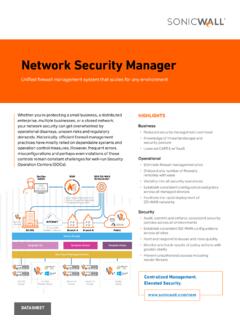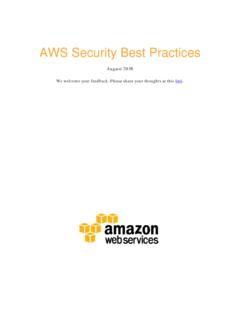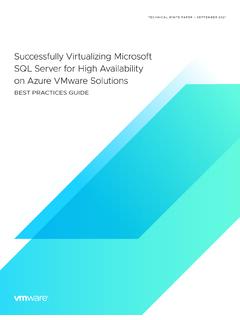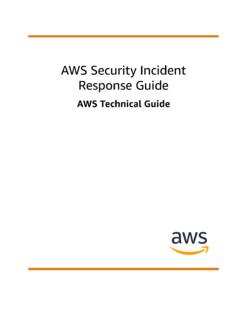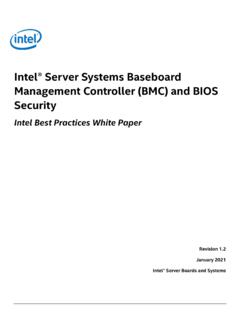Transcription of ARCHIVED: Amazon Web Services: Overview of Security …
1 ArchivedAmazon Web Services: Overview of Security Processes March 2020 This paper has been the latest technical content on Security and Compliance, see Customers are responsible for making their own independent assessment of the information in this document. This document: (a) is for informational purposes only, (b) represents current AWS product offerings and practices , which are subject to change without notice, and (c) does not create any commitments or assurances from AWS and its affiliates, suppliers or licensors. AWS products or services are provided as is without warranties, representations, or conditions of any kind, whether express or implied. The responsibilities and liabilities of AWS to its customers are controlled by AWS agreements, and this document is not part of, nor does it modify, any agreement between AWS and its customers. 2020 Amazon Web Services, Inc. or its affiliates. All rights reserved. ArchivedContents Introduction .. 1 Shared Security Responsibility Model.
2 1 AWS Security Responsibilities .. 2 Customer Security Responsibilities .. 2 AWS Global Infrastructure Security .. 3 AWS Compliance Program .. 3 Physical and Environmental Security .. 4 Business Continuity Management .. 6 Network Security .. 7 AWS Access .. 11 Secure Design Principles .. 12 Change 12 AWS Account Security Features .. 14 Individual User Accounts .. 19 Secure HTTPS Access Points .. 19 Security Logs .. 20 AWS Trusted Advisor Security Checks .. 20 AWS Config Security Checks .. 21 AWS Service-Specific Security .. 21 Compute Services .. 21 Networking Services .. 28 Storage Services .. 43 Database Services .. 55 Application Services .. 66 Analytics Services .. 73 Deployment and Management Services .. 77 ArchivedMobile Services .. 82 Applications .. 85 Document 88 ArchivedAbstract This document is intended to answer questions, such as How does AWS help me ensure that my data is secure? Specifically, this paper describes AWS physical and operational Security processes for the network and server infrastructure under the management of AWS.
3 ArchivedAmazon Web Services Amazon Web Services: Overview of Security Processes Page 1 Introduction Amazon Web Services (AWS) delivers a scalable cloud computing platform with high availability and dependability, providing the tools that enable customers to run a wide range of applications. Helping to protect the confidentiality, integrity, and availability of our customers systems and data is of the utmost importance to AWS, as is maintaining customer trust and confidence. Shared Security Responsibility Model Before covering the details of how AWS secures its resources, it is important to understand how Security in the cloud is slightly different than Security in your on-premises data centers. When you move computer systems and data to the cloud, Security responsibilities become shared between you and your cloud service provider. In this case, AWS is responsible for securing the underlying infrastructure that supports the cloud, and you re responsible for anything you put on the cloud or connect to the cloud.
4 This shared Security responsibility model can reduce your operational burden in many ways, and in some cases may even improve your default Security posture without additional action on your part. Figure 1: AWS shared Security responsibility model The amount of Security configuration work you have to do varies depending on which services you select and how sensitive your data is. However, there are certain Security ArchivedAmazon Web Services Amazon Web Services: Overview of Security Processes Page 2 features such as individual user accounts and credentials, SSL/TLS for data transmissions, and user activity logging that you should configure no matter which AWS service you use. For more information about these Security features, see the AWS Account Security Features section. AWS Security Responsibilities Amazon Web Services is responsible for protecting the global infrastructure that runs all of the services offered in the AWS Cloud. This infrastructure comprises the hardware, software, networking, and facilities that run AWS services.
5 Protecting this infrastructure is the number one priority of AWS. Although, you can t visit our data centers or offices to see this protection firsthand, we provide several reports from third-party auditors who have verified our compliance with a variety of computer Security standards and regulations. For more information, visit AWS Compliance. Note that in addition to protecting this global infrastructure, AWS is responsible for the Security configuration of its products that are considered managed services. Examples of these types of services include Amazon DynamoDB, Amazon RDS, Amazon Redshift, Amazon EMR, Amazon WorkSpaces, and several other services. These services provide the scalability and flexibility of cloud-based resources with the additional benefit of being managed. For these services, AWS handles basic Security tasks like guest operating system (OS) and database patching, firewall configuration, and disaster recovery. For most of these managed services, all you have to do is configure logical access controls for the resources and protect your account credentials.
6 A few of them may require additional tasks, such as setting up database user accounts, but overall the Security configuration work is performed by the service. Customer Security Responsibilities With the AWS cloud, you can provision virtual servers, storage, databases, and desktops in minutes instead of weeks. You can also use cloud-based analytics and workflow tools to process your data as you need it, and then store it in your own data centers or in the cloud. The AWS services that you use determine how much configuration work you have to perform as part of your Security responsibilities. AWS products that fall into the well-understood category of Infrastructure-as-a-Service (IaaS) such as Amazon EC2, Amazon VPC, and Amazon S3 are completely under your control and require you to perform all of the necessary Security configuration and management tasks. For example, for EC2 instances, you re responsible for management of the guest OS (including updates and Security patches), any application ArchivedAmazon Web Services Amazon Web Services: Overview of Security Processes Page 3 software or utilities you install on the instances, and the configuration of the AWS provided firewall (called a Security group) on each instance.
7 These are basically the same Security tasks that you re used to performing no matter where your servers are located. AWS managed services like Amazon RDS or Amazon Redshift provide all of the resources you need to perform a specific task but without the configuration work that can come with them. With managed services, you don t have to worry about launching and maintaining instances, patching the guest OS or database, or replicating databases AWS handles that for you. But as with all services, you should protect your AWS Account credentials and set up individual user accounts with Amazon Identity and Access Management (IAM) so that each of your users has their own credentials and you can implement segregation of duties. We also recommend using multi-factor authentication (MFA) with each account, requiring the use of SSL/TLS to communicate with your AWS resources, and setting up API/user activity logging with AWS CloudTrail. For more information about additional measures you can take, refer to the AWS Security best practices whitepaper and recommended reading on the AWS Security Learning webpage.
8 AWS Global Infrastructure Security AWS operates the global cloud infrastructure that you use to provision a variety of basic computing resources such as processing and storage. The AWS global infrastructure includes the facilities, network, hardware, and operational software ( , host OS, virtualization software, etc.) that support the provisioning and use of these resources. The AWS global infrastructure is designed and managed according to Security best practices as well as a variety of Security compliance standards. As an AWS customer, you can be assured that you re building web architectures on top of some of the most secure computing infrastructure in the world. AWS Compliance Program AWS Compliance enables customers to understand the robust controls in place at AWS to maintain Security and data protection in the cloud. As systems are built on top of AWS cloud infrastructure, compliance responsibilities are shared. By tying together governance-focused, audit friendly service features with applicable compliance or audit standards, AWS Compliance enablers build on traditional programs; helping customers to establish and operate in an AWS Security control environment.
9 The IT infrastructure ArchivedAmazon Web Services Amazon Web Services: Overview of Security Processes Page 4 that AWS provides to its customers is designed and managed in alignment with Security best practices and a variety of IT Security standards, including: SOC 1/SSAE 16/ISAE 3402 (formerly SAS 70) SOC 2 SOC 3 FISMA, DIACAP, and FedRAMP DOD CSM Levels 1-5 PCI DSS Level 1 ISO 9001 / ISO 27001 / ISO 27017 / ISO 27018 ITAR FIPS 140-2 MTCS Level 3 HITRUST In addition, the flexibility and control that the AWS platform provides allows customers to deploy solutions that meet several industry-specific standards, including: Criminal Justice Information Services (CJIS) Cloud Security Alliance (CSA) Family Educational Rights and Privacy Act (FERPA) Health Insurance Portability and Accountability Act (HIPAA) Motion Picture Association of America (MPAA) AWS provides a wide range of information regarding its IT control environment to customers through white papers, reports, certifications, accreditations, and other third-party attestations.
10 For more information, see AWS Compliance. Physical and Environmental Security AWS data centers are state of the art, utilizing innovative architectural and engineering approaches. Amazon has many years of experience in designing, constructing, and operating large-scale data centers. This experience has been applied to the AWS platform and infrastructure. AWS data centers are housed in facilities that are not ArchivedAmazon Web Services Amazon Web Services: Overview of Security Processes Page 5 branded as AWS facilities. Physical access is strictly controlled both at the perimeter and at building ingress points by professional Security staff utilizing video surveillance, intrusion detection systems, and other electronic means. Authorized staff must pass two-factor authentication a minimum of two times to access data center floors. All visitors are required to present identification and are signed in and continually escorted by authorized staff. AWS only provides data center access and information to employees and contractors who have a legitimate business need for such privileges.










